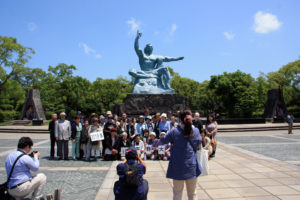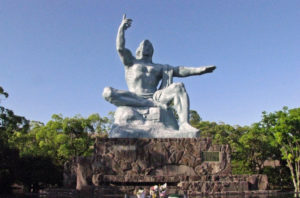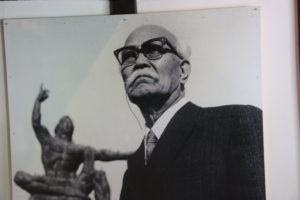Megane-bashi bridge
The oldest stone arch bridge in Japan. Meganebashi or Spectacles Bridge, over the Nakashima
River was built in Nagasaki in 1634 by the Chinese monk Mokusunyoujo who is a second
generation of Chinese monks living at Kofukuji Temple. It is said to be the oldest stone arch
bridge in Japan and has been designated as an Important Cultural Property.
 |
 |
 |
Megane Bridge is also part of the first group of bridges built over Nakashima River. Megane Bridge is
made of stone and is a double arch bridge. It received the nickname “Spectacles Bridge” because its
two arches and their reflection in the water create the image of a pair of spectacles.
 |
 |
 |
General information
| Address | Uonomachi, Nagasaki-city |
| Access |
3 minutes walk from Meganebashi Tram station |

Home Tailor-made tours Study tours Christian Pilgrimage tours Golf tour Kyushu tour packages
Former Shitsu Aid Center
I want to save people in the Sotome from poor life. Former Shitsu Aid Centeris indispensable
in talking about the history and culture of the region. In 1879, Father Marc Marie de Rotz,
a French missionary who has been assigned to the Sotome, has a variety of farming,
fishing, medical, and educational programs to save local residents from plight. I did an activity.
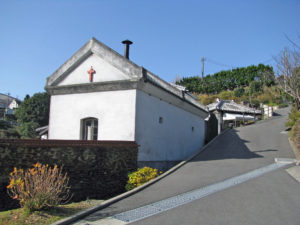 |
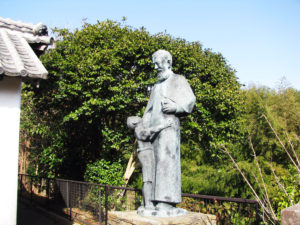 |
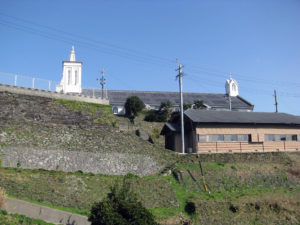 |
Former Shitsu Aid Center is a delivery facility for women, in 1883. It was founded with the
cooperation of members of the Church of St. Joseph, which was founded and trained by the
Father himself. In 2003 in 12, some of these facilities were designated as nationally
designated important cultural properties as the remains of valuable birth and welfare facilities
in the early Meiji period.

Home Tailor-made tours Study tours Christian Pilgrimage tours Golf tour Kyushu tour packages
Mount Inasa
Mount Inasa is one of the best view spot in Nagasaki. A 333 meter high mountain in close
distance to JR Nagasaki Station. The summit can be reached by ropeway or car and offers
great views over the city. And also, the magnificent night views from Mount Inasa is chosen
the three Major Night View in Japan along with Kitakyushu-city and Sapporo,
and the three Major Night View in the World along with Hong Kong and Monaco.
|
View from Nagasaki harbor |
Observatory |
Antenna for TV station |
|
Symbol for Nagasaki harbor |
View from the Observatory |
On the Viewing platform |
The three Major Night View in the World
 |
 |
 |
General information
Access
・20 minutes by car from JR Nagasaki station
・By Nagasaki bus and ropeway
10 minutes from JR Nagasaki station to Fuchi-jinjya Ropeway station
5 minutes from Fuchi-jinjya to sancho Ropeway station
・Inasayama Night View bus tour is available from Hotels in Nagasaki-city
by Nagasaki Yuran Bus

Home Tailor-made tours Study tours Christian Pilgrimage tours Golf tour Kyushu tour packages
Endo Shusaku Literary Museum
The peaceful Sotome, the setting of Endo Shusaku’s novel Silence. Sotome area of Nagasaki
city has an abundance of natural beauty in its sea, mountains and rivers. It also is blessed with
a unique history and culture of Christianity. In particular, the area in which the Endo Shusaku
Literary Museum stands is known as the site of a Christian village, one of Endo’s most notable
work, Silence.
 |
 |
 |
From the literary museum, there is a magnificent view. In a sweep of eye one can see sun as
it majestically sets over the sea of Goto, along with the Silence Literary Monument in Shitsu
Bunka Mura. Endo Shusaku and the Sotome area are linked through Silence ; this bond has
been built up starting from when Endo was writing the novel, and continues into the present day
with the construction of literary museum.
 |
 |
 |
Following Endo Shusaku’s death, this Literary Museum was established thanks to kindness of
his family, and was filled with Endo’s persona belongings, mementoes, manuscripts, and his
extensive collection of books. The Museum exhibits trace the footsteps of Endo Shusaku as
one of Japan’s greatest writers of literature. In addition, it has facilities for collecting, preserving,
and exhibiting materials related to Endo’s public perusal and research, and operating as an
information center.
 |
 |
 |
Note : Silence
Silence is a 1966 novel of theological fiction by author Endo Shusaku, published in English by
Peter Owen Publishers. It is the story of a Jesuit missionary sent to 17th century Japan, who
endures persecution in the time of Hidden Christians that followed the defeat of the Shimabara
Rebellion. The recipient of the 1966 Tanizaki Prize, it has been called “Endo’s supreme
achievement and “one of the twentieth century’s finest novels Written partly in the form of a letter
by its central character, the theme of a silent God who accompanies a believer in adversity was
greatly influenced by the Catholic Endō’s experience of religious discrimination in Japan, racism
in France, and a debilitating bout with tuberculosis.

Shitsu Church
Built in 1882 by Father de Rotz, this low-ceiling church features a brick exterior, wood interior
and stone entranceway. The roof itself is low in order to limit damage done by strong winds.
The church’s bell was brought here from France by a priest and rings out beautifully every
morning. The location is famous as the place where the movie “Gege” was filmed.
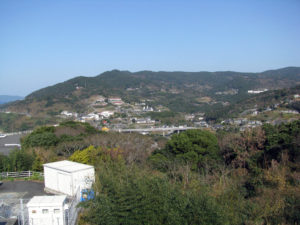 |
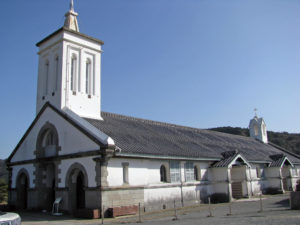 |
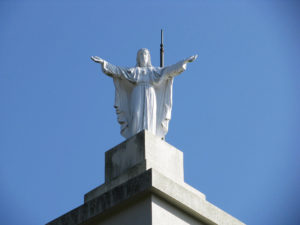 |

Kurosaki Church
The Church is located in Kurosaki district, where was place of the setting for Endo Shusaku’s
novel Silence. In 1897, the foundations were laid down according to Father de Rotz’s design.
Construction followed and in 1920 the church was completed.
 |
 |
 |
The followers built it brick by brick with their own hands. The modest design serves to bring out the
beauty of the bricks. Experience the depth when you come inside and see the rib vault ceiling.
The church’s stained glass also leaves a lasting impression.
 |
 |
 |

Kazagashira Park
Magnificent and panoramic view of Nagasaki-city. Kazagashira Park is located on the summit
of Kazagashira with 152 m high, and is on the other side of Inasa Mountain across Nagasaki
Harbour.
 |
 |
 |
At the observatory, there is the statue of Sakamoto Ryoma who greatly contributed
to overthrow the Tokugawa shogunate and make a new era.
 |
 |
 |
General information
| Address | 3 Irabayashi, Kazagashira-cho, Nagasaki-city |
| Access |
15 minutes by a vehicle from JR Nagasaki station |

Home Tailor-made tours Study tours Christian Pilgrimage tours Golf tour Kyushu tour packages
Peace Park
Peace Park was established in 1955 near the Ground Zero where the Atomic bomb was
dropped at 11:02 am on Aug. 09, 1945. Peace Memorial Ceremony is held in front of the
statue on August 9 every year and the Mayor of Nagasaki makes the “Nagasaki peace
declaration” for the whole world.
Completed in 1955, ten years after the Atomic bombing. The 9.7 meter high statue sitting on a 4
meter tall pedestal, made by renown sculptor Kitamura Seibo who born in Minami-Shimabara-city,
Nagasaki-prefecture in 1884. The raised arm points to the threat of nuclear weapons and the
out-stretched arm symbolizes peace.
|
Visiting from all over Japan and the World |
Wishing for eternal world peace from Nagasaki |
Kitamura Seibo, the Statue was completed at the age of 71 |
The Peace Fountain reminds us of the tragic scene unfolded shortly after America dropped the
Atomic bomb in Nagasaki at 11:02 am on Aug. 09, 1945.
 |
 |
 |
The plutonium Atomic bomb exploded about 500m over the central monument at 11:02 a.m.
on August 9, 1945. The most part of Nagasaki was destroyed, and a tremendous number of
lives were lost. And about 70,000 of Nagasaki’s 240,000 residents died instantly, and up to
60,000 were injured.
|
Nuked 50th Anniversary Monument |
Atomic bomb exploded over the central monument |
Ruin of destroyed Urakami Cathedral |
The museum exhibits a number of photograph that depict the devastation caused by atomic
bomb showing the lead-up to this tragic day, the history of the development of nuclear arms
and our desire for peace.
|
Destroyed Urakami Cathedral |
photograph |
Dr. Nagai Takashi |
General information
| Address | Heiwakoen, Matsuyama-machi, Nagasaki-city |
| Access | 3 minutes walk from Heiwa-koen-shita Tram Station |

Ground Zero
Pope Francis visited Nagasaki on November 24, 2019, and calls for a ‘world without nuclear
weapons’ at the Ground Zero.
 |
 |
 |
Disastrous War must not be repeated. The plutonium atomic bomb exploded about 500m over the
central monument at 11:02 a.m. on August 9, 1945. The most part of Nagasaki was destroyed, and
a tremendous number of lives were lost. And about 70,000 of Nagasaki’s 240,000 residents died
instantly, and up to 60,000 were injured.
|
The time, Atomic bomb was exploded |
Atomic bomb exploded over the central monument |
Nuked 50th Anniversary Monument |
The radius of total destruction was about 1.6km, followed by fires across the northern portion of the
city to 3.2km south of the bomb.
|
Cathedral |
Ruin of destroyed Urakami Cathedral |
The one leg Torii gate at Sanno Shrine |
The total number of residents died may have been as many as 80,000, including those who died
from radiation poisoning in the following months. Even now, many atomic bomb survivors are
suffering. The list of names of the atomic bomb victim who died up to now is stored in the monument.
|
The Bell of Nagasaki |
Peace Fountain |
Folding paper cranes pray for peace |
General information
| Address | Heiwakoen, Matsuyama-machi, Nagasaki-city |
| Access | 3 minuts walk from Heiwa-koen-shita Tram Station |

Home Tailor-made tours Study tours Christian Pilgrimage tours Golf tour Kyushu tour packages
Confucius Shrine
The world’s only Confucian shrine built outside China by Chinese hands. First built in 1893
by Chinese residents of Nagasaki with the support of the Ch’ing Dynasty government, the
shrine was designed to serve as a place of worship and learning for the Chinese community,
and housed a Confucian sanctuary and primary school.
 |
 |
 |
The buildings were severely damaged by the Atomic bomb explosion on August 9, 1945 and
were not restored and opened to the public until September 1967. The shrine was extensively
renovated in 1982. Standing outside the shrine are 72 statues representing the 72 followers
of Confucius.
 |
 |
 |
A building at the rear of the shrine houses the Museum of Chinese History and Palace Museum.
It features large illuminated photographs of the old Silk Road and models of early Chinese
inventions such as the world’s first seismograph. Displayed on the second floor are more than
80 treasure-class articles of varying antiquity on loan directly from the Chinese National Museum
and Palace Museum in Beijing.
 |
 |
 |
General information
| Address | 10-30 Oura-machi, Nagasaki-city |
| Access |
5 minutes walk from Oura-kaigan-dori Tram Station or 3 minutes walk from Oura Tenshudo Tram Station |
| Open hours | 9:30 to 18:00 |
| Admission fee | JPY 600 |
| Days closed | No closing days |







